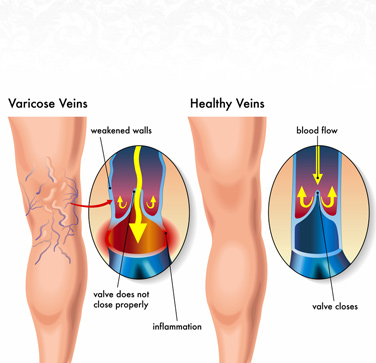Spider veins, also known as telangiectasia or hemangiomas, are red and purple blood vessels near the surface of the skin. They usually appear on the legs and face, measuring up to one millimeter in diameter. Statistics show that at least half of all women are affected by this condition. Spider veins are typically not palpable. Unlike varicose veins, they tend to develop in clusters. Both men and women can develop spider veins.
What Causes Spider Veins?
This health condition is linked to a number of factors, including heredity, hormonal imbalances, obesity, and occupations that involve a lot of standing. Spider veins usually occur during pregnancy, menopause, and puberty. Other causes include the use of birth control pills, exposure to ultraviolet rays, and injury to the skin. It is estimated that 30 to 60 percent of adults have spider veins.
Pregnancy is one of the main factors contributing to the development of spider veins. Having family members with vein problems increases your risk. Spider veins that appear on the cheeks or nose are usually caused by sun exposure. Other risk factors include a sedentary lifestyle and postmenopausal hormonal replacement. This condition may occur at any age, but it is more common in adults between the ages of 18 and 35.
The Symptoms of Spider Veins
More than 60 percent of the patients with spider veins experience pain, swelling, itching, burning, bleeding, and phlebitis. When left untreated, this condition may cause chronic leg ulceration, hemorrhage, and deep venous thrombosis. In women, symptoms may be worse during pregnancy. Some patients develop ulcers and painful blood clots with inflammation of the vein. Other symptoms include:
• Aching pain
• Darkening of the skin
• Rashes
• Heaviness in legs
• Cramping
• Fatigue
• Skin ulceration
• Stasis dermatitis
• Tingling
• Cellulites
• Bleeding
These symptoms are the result of decreased blood flow in the affected areas. Swelling may also occur due to inflammation of the weakened veins. In rare cases, spider veins may lead to severe health problems such as pulmonary embolism, postphlebitic syndrome, and persistent low-grade inflammation. If the skin on the ankle becomes thick and changes color, contact your physician immediately.
Treatment Options
Spider veins can be treated on an outpatient basis. If you suffer from this condition, it is recommended to wear compression stockings and avoid long periods of standing or sitting. Compression stockings improve blood circulation and prevent spider veins from getting worse.
Other treatment options include sclerotherapy, vein stripping, laser surgery, endoscopic vein surgery, ambulatory phlebectomy, and catheter-assisted procedures. Sclerotherapy is one of the most effective treatments for spider veins. This procedure uses a saline solution that is injected into the veins. Your doctor may also recommend laser surgery, which makes the veins fade and disappear.
Surgical procedures to treat spider veins include stripping and litigation. Doctors often use intense pulsed light treatments to destroy abnormal veins. Most therapies have high success rates and provide fast results. Ongoing treatment can help keep spider veins under control. Contrary to popular belief, telangiectasia is not a cosmetic condition because the disease is often associated with venous insufficiency and other severe complications.
About this article: Vein Clinics of Ireland is a professional and courteous service dedicated to the treatment of varicose veins and spider veins. For further information on vein treatments visit this cosmetic clinic.
